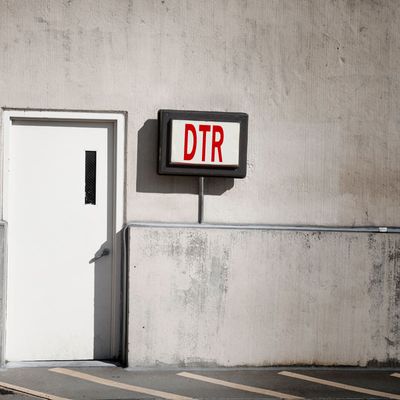
My friend Alex recently had an alarming experience at a party. Introducing his date to a new friend, she interjected that she was his girlfriend. “We never defined the relationship,” he lamented later over a beer. Looking forlornly at his phone, he wondered if his continued use of Tinder constituted cheating.
“Are you sure you didn’t DTR?” I asked.
As consumers of self-help and women’s media know, the DTR is a conversation in which two parties Define the Relationship. Amid the emotional anarchy of casual dating, a DTR ensures both partners are on the same page. It can turn a casual relationship into a serious one by establishing sexual exclusivity, or limit a casual relationship by announcing non-availability. (“You’re looking for a husband? I thought you knew I had a wife.”) Though DTRs vary in awkwardness and outcome, all share one uniting purpose: clarity.
As Alex sipped his beer, we went over the chronology. He met his girlfriend on OkCupid two months ago. The early dates were immersive experiences, 24-hour wine-and-dine sleepovers that left both parties high on serotonin for days. When they were together, they couldn’t keep their hands off each other. When they were apart, they texted. During one of those honeymoon texting sessions, she stated, “I deactivated my OkCupid account.”
“I scrambled to the site, deactivated mine, and texted back, ‘So did I,’” Alex recalled.
I delivered my verdict straight, like a grimly sexy female detective on a procedural justice TV show. “You’re in a relationship, Alex. You were backdoor DTR’ed.”
Backdoor DTR sounds like a dirty sex move, but it is the term I am using for defining a relationship’s parameters through misdirection. Technically, Alex had not agreed to sexual exclusivity. But his girlfriend had used OkCupid deactivation to announce she was no longer seeking alternate mates. (In poetry, this would be called synecdoche, part of her dating life meant to represent the whole.) By continuing to use Tinder, Alex was not violating the letter of his DTR. But he was violating its spirit, and he knew it.
Dating technology did not invent the backdoor DTR. (You could argue that shotgun weddings are a form of backdoor DTR.) But as the Information Age expands the forms of communication available to suitors, it also offers parallel possibilities for miscommunication — both accidental and willful.
Take the display of digital pictures. Uploading smoochy pics to Facebook could point, simply, to a smoochy friendship. But uploading a smoochy picture as your profile portrait suggests that the smooch in question is central to your identity — sending a strong message about your relationship with the smoocher. (Or the relationship you wish you had with the smoocher, as was the case when my friend Omar’s ex-girlfriend used a couple portrait to trigger a reunification.) Conversely, discovering that a casual date has been uploading smoochy pictures of others confirms non-exclusivity.
“My backdoor DTRs are usually the great ways I find out I wasn’t dating someone I thought I was,” my friend Beejoli said when I asked her about the matter. “Although I did once ask a college boyfriend, with all the nonchalance I could muster, ‘Oh, this is so dumb, but all my friends keep bugging me about why we haven’t thrown ‘in a relationship’ up on Facebook.’ I kept blaming my random friend as this witch hellbent on Facebook defining everyone, and the two of us victims of her (wholly manufactured) scrutiny.”
“He laughed and did nothing, so I had to bring it up again a week later. We made the change simultaneously. I think we both had our laptops. It was probably karma when, breaking up a month later, the first thing he said very softly mid-breakup was, ‘Should we go upstairs … ?’ And I thought he meant for goodbye sex. But then he continued, ‘We can change our Facebook statuses together.’”
Though Alex’s and Beejoli’s backdoor DTRs are both examples of women pushing for exclusivity, the backdoor DTR can be deployed by either gender, to any outcome. A backdoor DTR can slow commitment. (Think of the hookup who whispers, during a postcoital embrace, “I don’t really believe in monogamy.”) Nevertheless, my informal polling revealed more female-induced backdoor DTR-ing than male, perhaps as a strategy for reconciling the contemporary imperative to be a “cool girl” with older pressures to couple off. The backdoor DTR allows the instigator to maintain her laid-back aura. She’s too chill to care about labels, it’s just that her friends — those nosy friends! — who keep asking whether it’s “official.”
On dates, we present our best, most sexually available selves — the ones who banter wittily, wear cute outfits, and have charming laughs. We may be available for the night, or several nights, or a lifetime. We DTR to make our relative availability explicit and agreed upon.
And that’s where Alex went awry. “Come on, you knew the OkCupid thing was a sign of exclusivity,” I said in my best righteously sassy female detective voice. “Yeah, but …” Alex trailed off. “I must sound like a real asshole, but I promise I’m not.” He resolved to communicate more clearly, figure out what he wanted, and take decisive action with his relationship.
Two days later, I asked Alex if I could write about his backdoor DTR. “Sure thing!” he replied. “Worst case, we get in a fight and break up, but I’d be okay with that.”
“Oh my god. You are trying to backdoor DTR your way out of this via anonymous article!” It was like the mid-season special where the female detective realizes that, though she believes she has uncovered a criminal mastermind’s ruse, she has been playing into his hands all this time.
“Easy out,” Alex replied. “I’m awful.”
Some names, including awful Alex’s, have been changed.




